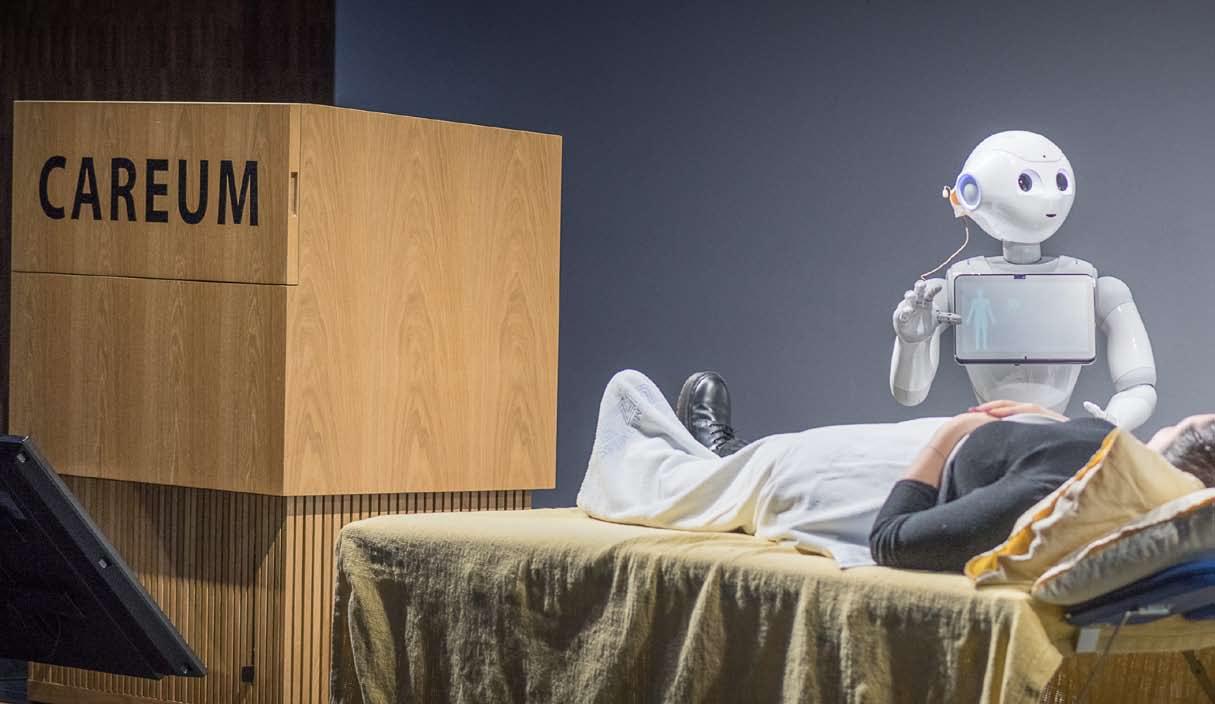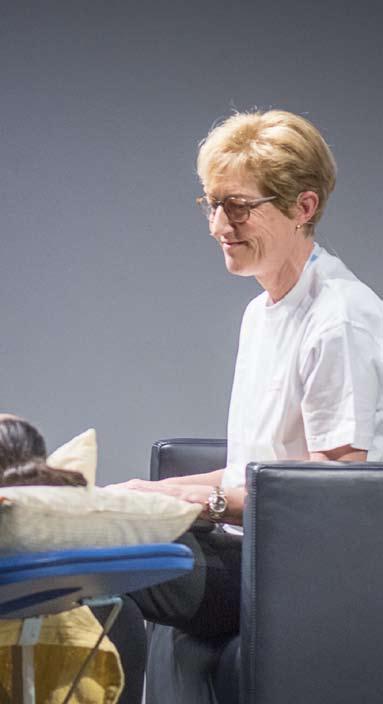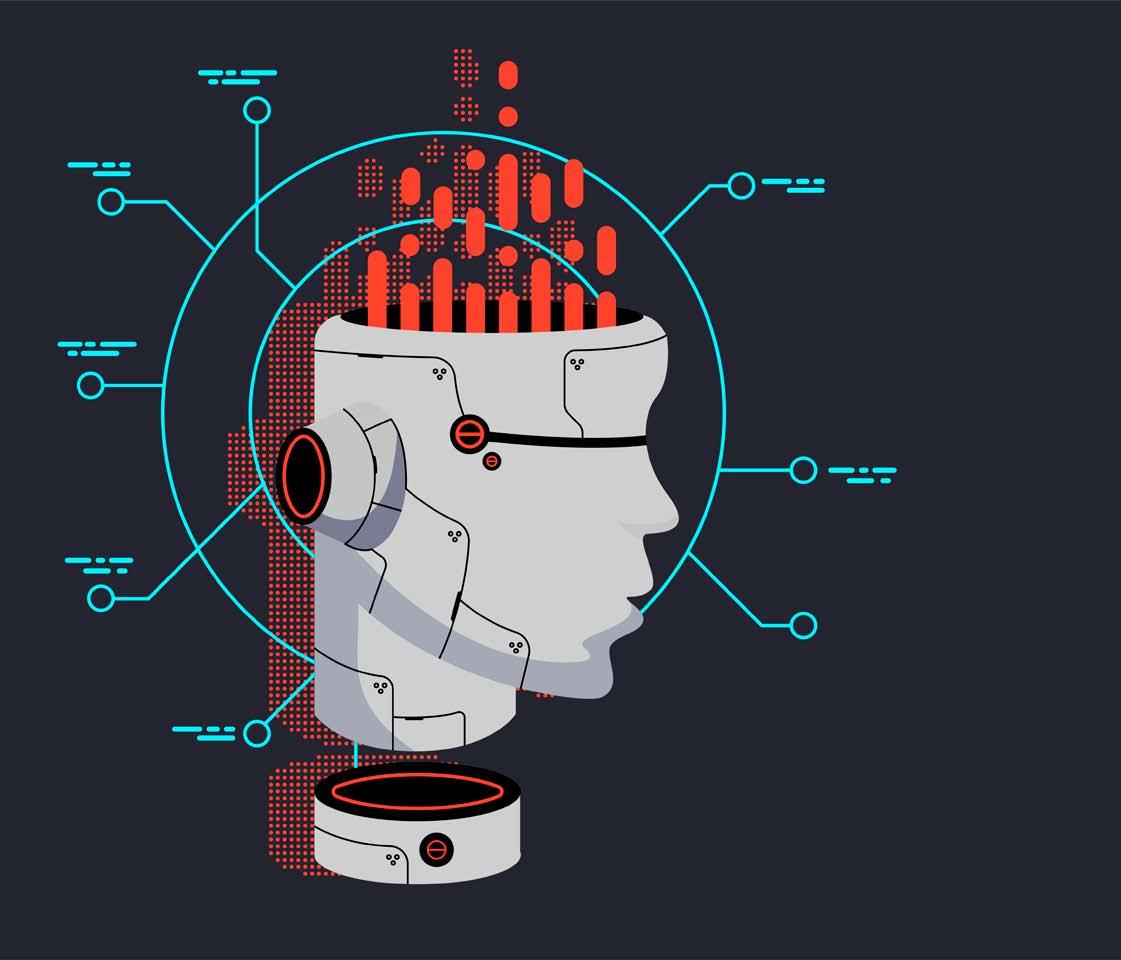
13 minute read
Help me, robot
from OSOZ World
by OSOZ Polska
They help the disabled, entertain patients in hospitals, and support therapies for autistic children. But from robots in healthcare, we expect much more than just manual help. We want human touch. Robots augmented with social abilities should react to our emotions and create authentic relationships so we can trust them. What care do we want in the future? And how can we involve robots to make health care smarter?
A patient with emotional baggage A small, white robot with big eyes enters the patient’s room. It asks the patient about their mood, provides sufficient information on their condition, carries out a medical interview and checks blood pressure. It analyzes all information through the Artificial Intelligence system. A diagnosis is ready in a few seconds. The patient receives a prescription, an exhaustive list of recommendations and a bill. It seems that an ideal patient visit, during which perfect service and medicine based on facts, i.e. data, should look like this. But an ideal doctor-robot is not able to satisfy the patient’s emotional needs, which are equally important as treating a disease. It does not show emotions and empathy, and it does not accept any comments. It follows the procedure authoritatively.
Advertisement
Although robots as machines perform well on a production line, interaction, communication, support and empathy are more significant when it comes to medical care. In short, it is more important to meet social needs that are one of the most significant needs on the ladder of all needs. At the same time, they are the most difficult to satisfy, as they are intangible and elusive, and they vary among people. We realize social interactions differently, just like we alleviate hunger through food adjusted to our taste and culture (as long as we can afford this luxury).Everything depends on the living environment, upbringing, personality and priorities. While experiencing disease, all emotions which are present in a human being are brought to a boil. In this

kind of situation, we look for understanding and help, and not only a prescription or treatment.
Social robots are getting better and better at recognizing and reacting to our emotions. Voice assistant Alexa is already capable of intoning utterances, expressing feelings and communicating with a human being in a better way. So far, these are only two emotions, i.e. excitement and disappointment. In a few years, Artificial Intelligence will learn more natural language and voice modulation, so that we will not be able to tell the difference between a chat with a friend and a chat with algorithms. Cameras built into robots, similarly to human eyes, carefully observe and analyze expressed feelings so that they can adjust to them and react individually.
Robots are able to gain our trust only by behaving like a human being. We want them to be able to talk with us and to treat us individually as well as arouse various emotions. The number of robots which are able to do this is increasing. Paro, which resembles a seal, is a favorite among patients suffering from Alzheimer’s disease and dementia. There is an authentic relationship between Paro and patients, which is the same as the relationship between a human being and a real animal, e.g. a dog or a cat. There are other examples similar to this. Moxi, which was designed to help nurses, is an attraction among patients who treat it as something more than a soulless machine. Also, Pepper is one of the most popular robots, which is able to work at the hospital reception and help in the therapy of autistic children.
The issue of the social skills of robots is the subject of many elaborations. In the PubMed scientific library, upon entering the term ‘social robots’, we obtain 1,400 abstracts. A majority of them examine the potential of their usage in care of people with special needs, such as patients with neurodegenerative diseases or children suffering various diseases. One can also find there critical texts, which draw attention to the dehumanization of social contacts in health care, which is the beginning of the epoch of post-humanism.
Binary healthcare full of empathy Technology is never neutral. The development of robots with social competences will also have far-reaching consequences, which will affect society, social relationships and the definition of a human being. Intelligent machines that are able to recognize our feelings more precisely than another person seem terrifying but also fascinating. The Japanese invention called Gatebox, which is a virtual friend in the form of a hologram, may serve as a good example. This personalized avatar remembers things about its owner better than the best partner. It is curious about how we spent our day, it asks us how we are, and it is happy when we come back from work. Some people consider it to be a sad invention, which demonstrates the dissolution of social bonds. However, for some people, it as an excellent innovation, which helps lonely people, who are not able to establish real connections, have a new companion.
However, today is not the right time to ask questions about what we expect from health care. When the question of what is important for us as people is asked, I always ask what we mean by ‘we’? Do we have a moral right to judge a lonely, bedridden person, whose only friend and assistant is a robot, because their family does not have time to visit them or prefers to spend the weekend outside the city? Is a companion of an ill child in the hospital in the form of the Huggable robot created by MIT a fraud or support in difficult moments? Everyone values different things. Everything depends on many factors and perspective. Therefore, it is difficult to generalize questions about robotics in healthcare. It is wiser to consider what we want to avoid.
One thing we know for sure is that robots used in health care should not cause harm. Similarly to doctors, in accordance with the ethical principle of Hippocrates primum non nocere, although in a different context. Therefore, robots should not collect information for purposes other than the ones concerning care over patients. They cannot act as a spy standing next to the patient’s bed. Algorithms controlling these type of solutions should be created transparently and ethically. Robots should remain emotionally neutral so as not to manipulate feelings or raise any hope that they can do more than in reality. However, there is a fine line. Does a machine which holds the patient’s hand or hugs them violate ethical standards? At the moment, robots should not make independent and un-programmed decisions. The reason is simple: the real world is too complex for the perception of an average robot, and even the best algorithm of Artificial Intelligence is not able to analyze a given situation as precisely as the human mind, paying attention to the smallest details and nuances. Robots should also be neutral in terms of their attitude towards patients (lack of prejudices and partiality) and collect only such data which patients want them to collect.
Synthetic empathy or a virtual lie? Bart de Witte, the founder of Digital Health Academy, predicts that empathy generated by the Artificial Intelligence systems will become one of the leading trends in few years. People establish relationships based on trust with machines when they understand our emotions and are able to react adequately. Today’s Artificial Intelligence is very limited. At present, many services use other psychological mechanisms in order to increase the use of a given technology. Social me-
dia, which is addictive because they it is based on the simple principles of the psychology of behaviors and the stimulation of a reward center in the brain, are a good example. Therefore, each ‘like’ generates the feeling of happiness, acceptance and strengthens self-confidence. But in a few years, Artificial Intelligence will enter virtual reality by imitating the behavior of a human being. Robots which act as doctors during telemedical consultations, which do not require a physical meeting with a doctor, can be equipped with synthetic empathy. We will require such robots to establish ideal bonds with us, not to criticize us and to help us feel better. Will it then turn out that a conversation with another human being, during which we often face criticism or another point of view, is too toxic?
“Technology can always be threat or a chance for humanity. It is us – people – who define the purpose of technology. Currently, many of the business models digital companies use are based on digital services that compete for users’ limited attention. The modern economy increasingly revolves around the human attention span and how digital services capture that attention,” Bart de Witte, the Founder of the HIPPO AI Foundation and Digital Health Academy says.
“The addiction to social validation and bursts of “likes”, for example is destroying our real life attention spans. Our brains are drawn to outrage and angry tweets, replacing democratic debate. During the last few years, access to technology’s godlike powers has increased dramatically, while the ancient, Paleolithic impulses of our brains have remained the same. What happens when we add the power of love in the box of god-like technologies and give it to 25year-old nerds, backed up by venture capital? Algorithms are already able to read our emotions much better than we humans do, but as they do not possess con-

sciousness, they won’t have the ability to feel. Empathic behavior will be based on synthetic empathy. Giving robots emotions has been an abiding theme, in literature and pop-culture. When the Tin Man in the Wizard of Oz wanted a heart, he was told that a heart is not judged by how much you love, but by how much you are loved by others. Synthetic empathy will be the most powerful tool developers have ever had access to. Before we all fall in love and enslave ourselves, we need a more open debate on how far we need to regulate this,” Bart de Witte points out.
At this point the question whether we will shape technology or whether technology will shape us arises again. So far, this technology has been formulating a new world order in new technologies. They are not as controversial as cloning or editing genes about which most countries have similar opinions, introducing legal barriers jointly and severally. The influence of digital innovations is far subtler, long-term and difficult to predict. Perhaps it is equally dangerous.
Experiment on patients It is not possible to clearly separate roles which should be fulfilled in healthcare by robots and by human beings. Medical care provided, for example, by a nurse is the mixture of technical and social tasks. It is also difficult to think about target models, as technology is changing dynamically and tomorrow today’s ideas may be outdated.
The market does not stand still either. It experiments with the growing number of the new models of robots implemented in pilot projects. A number of them were created by innovative startups the ambition of which is to develop a revolutionary technology and achieve market success, not to analyze values significant for patients. Most of these projects fail, but projects that pass the market test join other innovations and create the force changing current health care. A good example is the above-mentioned Moxi created by Diligent Robotics. The Zora Robot, which costs about $10,000, is one of the most popular humanoids. It is used in care centers, where it entertains patients, talks with them, dances, exercises, and makes patients laugh.
The evolution of machines-carers has significantly sped up along with the development of Artificial Intelligence and the so-called neural networks. Robots which accompany patients and people who require special care may learn their needs, habits and gradually adjust their skills.
The GrowMeUp project implemented in the years 2015-2018, which was co-funded by the EU Horizon 2020 program, was one of the largest projects in this respect. The project’s objective was to develop a cheap robotic system which would be able to learn the needs and habits of the elderly, recognize their habits and grow up with them. In this way, robots would be able to compensate the deterioration of the senior’s cognitive abilities and support them in everyday life so that they are active, independent and socially engaged for a longer period of time. Robots would transfer the collected data and knowledge to a data cloud, so that they could learn from each other and create a combined virtual care network. The project ended up with no success.
Robotics in healthcare is like walking on thin ice. The lack of regulations leads to the uncertainty. Moreover, such projects are rarely funded in public healthcare systems. Therefore, it is difficult to create a stable business model. This poses the threat that only more affluent people will benefit from robots. Interestingly, many experts believe that the situation may be completely different. If the mass production of robots results in the fact that they are cheaper labor force than people, poorer patients will be served by machines, and only richer patients will be served by a real human being.
In the middle of extreme scenarios Robots are new labor force which is meant to fill the increasing gap related to the lack of doctors and nurses. It will be relatively easy to teach machines how to take care of patients, change the sheets, bring meals to bed, measure body temperature and control the general health condition. Robots, whose competences will be reduced only to the foregoing skills, will remain only mechanical assistants. If they perform tasks carried out by human beings, we want them to look and behave like human beings. Therefore, such robots as Moxi or Pepper have human faces, big eyes and a broad smile. Thanks to this, they do not frighten patients but make them feel more comfortable. However, nowadays, it is difficult to imagine that healthcare based on human beings could be exchanged for a model based on robots, where machines take over all of the competences belonging to doctors and nurses, and take care of patients on their own; at least not at the moment, due to the lack of sufficient technical capabilities. When a few years ago I read about the Paro robot, which helps taking care of patients suffering Alzheimer’s disease, I was delighted by the idea. However, I was extremely disappointed when I held it in my hands. Mechanical, clumsy movements, monotonous murmurs and robotic eye movements turned out to be a very crude form of what real animals can do.
“We hold a tool in our hands, which can be an opportunity for but also a threat to healthcare. In order for technology to become the Trojan Horse introduced by companies providing new technologies for healthcare, we must get involved in its development, participate in research projects, discuss their application with patients, politicians and all stakeholders” – global health expert, professor Ilona Kickbusch, rightly claims. It will take years before robots learn such basics as smooth movement around hospital rooms or starting relatively neutral conversation with patients. Meanwhile, we have the time to focus on the development of the model of intelligent and comprehensive healthcare (‘smart care’ and ‘deep care’), where robots support personnel, assist them in mechanical and physical activities and leave the sphere of communication, empathy and emotions to human carers.
However, we know that human curiosity and willingness to experiment with Artificial Intelligence and technologies will still accelerate newer and newer models of robots imitating human behavior. And there will be nothing wrong with this, as long as they help patients instead of harming them.
Author: this article is based on knowledge I gained during the “Talk to Me – Social Robots in Health Care” conference organized by the Careum Foundation, 13-14 February. Special thanks for inspiring visions and experiences to: prof. Ilona Kickbusch, Jan Ehlers, prof. dr. Oliver Bendel, Kathrin Janowski, prof. dr. Effy Vayena, prof. dr. Marc Oliver Korn, prof. dr. Detlef Günther, Bart de Witte.










